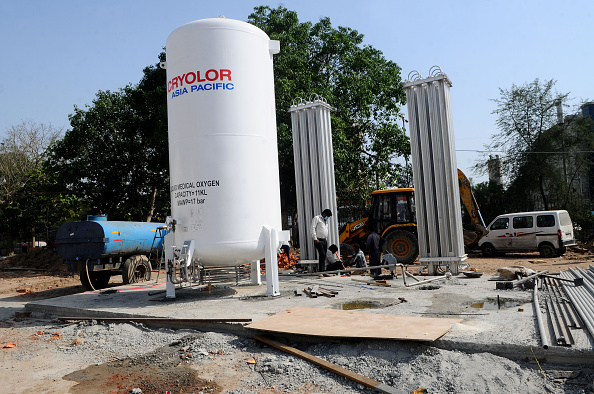
Engineers and labourers stalling oxygen cum storage plant at the Ramleela Maidan ground which was temporarily converted into a Covid-19 coronavirus care center, in New Delhi PHOTO: Getty
“Approved Medical Oxy Prodn Promotion Policy. It provides several incentives to pvt sector to set up oxy prodn plants, invest in Oxy tankers n set up oxy storage facilities. This will help improving oxy availability in Del which became a huge bottleneck in handling last Covid wave (sic),” Chief Minister Arvind Kejriwal said in a tweet.
The proposal for the “Medical Oxygen Production Promotion Policy 2021” with provisions for incentives has been approved. The policy aims to make Delhi self-reliant in the production of medical oxygen to meet any crisis or medical emergency in the future, the city government said in a statement. With the new policy, the government aims to set up liquid oxygen (LOX) generation plants with a minimum capacity of 50 metric tonnes per unit. The total targeted capacity is 100 MT. It also targets installation of non-captive oxygen generation plants (PSA or Air Separation Unit technology) of minimum 10 MT and maximum 50 MT capacity (till a total capacity of 100 MT is created).
“Power subsidy will be made available to liquid oxygen generation plants and non-captive oxygen generation plants at Rs 4 per unit consumed in the manufacturing process for the first five years from the date of commencement of commercial production,” the statement said.
The policy also aims to encourage the private sector to set up captive oxygen generation plants of minimum 500 LPM (litres per minute) capacity at hospitals and nursing homes to cater to their peak demand for medical oxygen and LMO storage tanks of a minimum capacity of 10 MT. “Full reimbursement of gross SGST will be made to liquid oxygen generation plants and non-captive oxygen generation plants within a month of their commissioning,” the government said.
Delhi battled against an acute shortage of oxygen in April and May as hospitals sent out SOS calls to authorities to replenish their dwindling stocks. Several private healthcare facilities even requested the government to move out their patients.
On April 23, 21 critically-ill Covid-19 patients died at the Jaipur Golden Hospital in northwest Delhi due to an oxygen shortage. The Batra Hospital in the Tughlakabad Institutional Area lost eight lives due to an oxygen shortage on May 1. To prevent a repeat of the crisis, the city government is in the process of installing oxygen generation plants and increasing the number of hospital beds to accommodate 37,000 cases a day in case of a third wave of the pandemic.
According to officials, around 160 Pressure Swing Adsorption (PSA) oxygen generation plants with a total capacity of 148.11 metric tonnes are being installed at various government and private hospitals in the city.
While 66 plants are being installed in Delhi government hospitals, 10 are being set up in hospitals run by the Centre and 84 in private healthcare facilities.
The Aam Aadmi Party (AAP) government in Delhi is also creating LMO storage facilities and has floated a tender to procure 15 cryogenic tankers with a total carrying capacity of 225 tonnes.
A subsidy will be provided for “setting up cryogenic tankers” with a minimum carrying capacity of 10 MT for ferrying liquid medical oxygen.
The decline is primarily due to damage to the "heart-brain link" triggered by chronic kidney…
A French-style open-air café is drawing Delhiites back to a river they long forgot
The handset features a dual rear cameras, 6.72-inch 144Hz display, IP64 water resistance, and up…
Delhi Police raided a late-night illegal bar in Samaypur Badli, detaining 25 people and seizing…
A rear-end crash near Delhi Haat triggered a blaze that gutted both vehicles, though no…
Court grants probe agency more time as NIA pursues wider links in Red Fort blast…